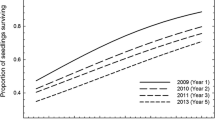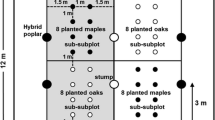Abstract
A seedling size/intensive management study with Pinustaeda L. was established in 1993 on two sites in the CoastalPlain of Georgia and South Carolina. Each site contained a 2 × 2split-plot study involving two seedling sizes and two levels ofestablishment intensity. Ideotype ``B'' seedlings averaged 5.0 mmin diameter (at the root collar) and were 43 cm tall. Ideotype``A'' seedlings averaged 8.5 mm in diameter and were 50 cm tall. ``Standard'' establishment practices included herbicides(hexazinone and sulfometuron) and fertilizer (DAP) appliedduring the first year. The ``intensive'' management involved twoherbicide applications during the first year and two during thesecond year, fertilizer during the first and third years, andinsecticide applications during the first two years (for controlof tip moth, Rhyacionia frustrana Comstock).Intensive management did not affect survival but planting largerseedlings increased survival slightly on one site. However,treatments affected early growth at both sites. On both sites,fourth-year plot-volumes were increased with greaterestablishment intensity and larger seedlings but there was nointeraction between stock size and establishment intensity. Early growth gains were greatest when both intensive managementand larger seedlings were combined. Depending on site, thiscombination resulted in 21% to 51% more volume (at age 4) thanthe next best treatment (standard seedlings with intensivemanagement).
Similar content being viewed by others
References
Anonymous. 1998. Forest landowner nursery directory. Forest Landowner 57(5): 22–35.
Barber, B.L., Messina, J.S., van Buijtenen, J.P. and Wall, M.M. 1991. Influence of nursery fertilization, site quality, and weed control on first-year performance of outplanted loblolly pine, pp. 27–37. In: Coleman, S.S. and Neary, D.G. (Eds.) Proceedings of the Sixth Biennial Southern Silvicultural Research Conference. October 30–November 1, 1990, Memphis, TN. USDA For. Serv. Gen. Tech. Rep. SE-70.
Barnett, J.P. and McGivary, J.M. 1993. Performance of container and bareroot loblolly pine seedlings on bottomlands in South Carolina. South. J. Appl. For. 17: 80–83.
Blake, J.I. and South, D.B. 1991. Planting morphologically improved seedlings with shovels. Ala. Agr. Exp. Sta. Forestry School Series No 13. 7 p.
Cossitt, F.M., Rindt, C.A. and Gunning, H.A. 1949. Production of planting stock, pp. 160–169. In: Stefferud, A. (Ed.) Trees: The Yearbook of Agriculture, U.S. Government Printing Office, Washington, D.C.
Cram, M.M., Mexal, J.G. and Souter, R.A. 1997. Pisolithus tinctorius mycorrhizae inoculation provides little benefit for longleaf and loblolly pine on the Savannah River site, pp. 126–133. In: James, R.L. (Ed.) Proceedings of the Third Meeting of IUFRO Working Party S7.03-04: Diseases and Insects in Forest Nurseries, 19–24 May 1996, Gainesville, FL. USDA For. Serv. Northern Region Forest Health Protection Rep. 97-4.
Dubois, M.R., McNabb, K. and Straka, T.J. 1999. Costs and cost trends for forestry practices in the South. Forest Landowner 58(2): 3–8.
Harrington, T.B. and Howell, K.D. 1998. Planting cost, survival, and growth one to three years after establishing loblolly pine seedlings with straight, deformed, or pruned taproots. New For. 15: 193–204.
Irwin, K., Duryea, M.L. and Stone, E.L. 1998. Fall-applied nitrogen improves performance of 1-0 slash pine nursery seedlings after outplanting. South. J. Appl. For. 22: 111–116.
Lowery, R.F. and Gjerstad, D.H. 1991. Chemical and mechanical site preparation, Chapter 13. In: Duryea, M.L. and Dougherty, P.M. (Eds.) Forest Regeneration Manual, Kluwer Academic Publishers. Dordrecht, Netherlands. 433 p.
Miller, J.H., Zutter, B.R., Zedaker, S.M., Edwards, M.B. and Newbold, R.A. 1995. A regional framework of early growth response for loblolly pine relative to herbaceous, woody, and complete competition control: The COM Project. USFS Gen. Tech Rep. SO-117. 48 p.
Ross, D.W. and Berisford, C.W. 1990. Nantucket pine tip moth (Lepidoptera: Tortricidae) response to water and nutrient status of loblolly pine. For. Sci. 36: 719–733.
Ross, D.W., Berisford, C.W. and Godbee, J.F. 1990. Pine tip moth, Rhyacionia spp., response to herbaceous vegetation control in an intensively site-prepared loblolly pine plantation. For. Sci. 36: 1105–1118.
South, D.B. 1993. Rationale for growing southern pine seedlings at low seedbed densities. New For. 7: 63–92.
South, D.B. 1999. Which loblolly pine seedling has a higher surival potential, a deep planted J-root or a shallow planted I-root?, pp. 350–355. In: Haywood, J. (Ed.) Proceedings of the Tenth Biennial Southern Silvicultural Research Conference. February 16–18, 1999, Shreveport, LA. J. USDA For. Serv. Gen. Tech. Rep. SRS-30.
South, D.B. and Barnett, J.P. 1986. Herbicides and planting date affect early performance of container-grown and bare-root loblolly pine seedlings in Alabama. New For. 1: 17–27.
South, D.B., Boyer, J.N. and Bosch L. 1985. Survival and growth of loblolly pine as influenced by seedling grade – 13 year results. South. J. Appl. For. 9: 74–79.
South, D.B. and Mitchell, R.J. 1999. Determining the “optimum” slash pine seedling size for use with four levels of vegetation management on a flatwoods site in Georgia, U.S.A. Can. J. For. Res. 29: 1039–1046.
South, D.B. and Zwolinski, J.B. 1997. Transplant stress index: A proposed method of quantifying planting check. New Forests 13: 315–328.
South, D.B., Zwolinski, J.B. and Allen, H.L. 1995. Economic returns from enhancing loblolly pine establishment on two upland sites: Effects of seedling grade, fertilization, hexazinone, and intensive soil cultivation. New For. 10: 239–256.
Sung, S.S., Black, C.C., Counce, P.A. and Kormanik, P.P. 1997. Fall nitrogen fertilization and the biology of Pinus taeda seedling development. Can. J. For. Res. 27: 1406–1412.
VanDusen, P.C., Sullivan, A.D. and Matney, T.G. 1981. A prediction system for cubic foot volume of loblolly pine applicable through much of its range. South. J. Appl. For. 5: 186–189.
Wakeley, P.C. 1954. Planting the Southern Pines. USDA Agric. Monograph 18. 233 p.
Author information
Authors and Affiliations
Rights and permissions
About this article
Cite this article
South, D.B., Rakestraw, J.L. & Lowerts, G.A. Early gains from planting large-diameter seedlings and intensive management are additive for loblolly pine. New Forests 22, 97–110 (2001). https://doi.org/10.1023/A:1012097924355
Issue Date:
DOI: https://doi.org/10.1023/A:1012097924355




